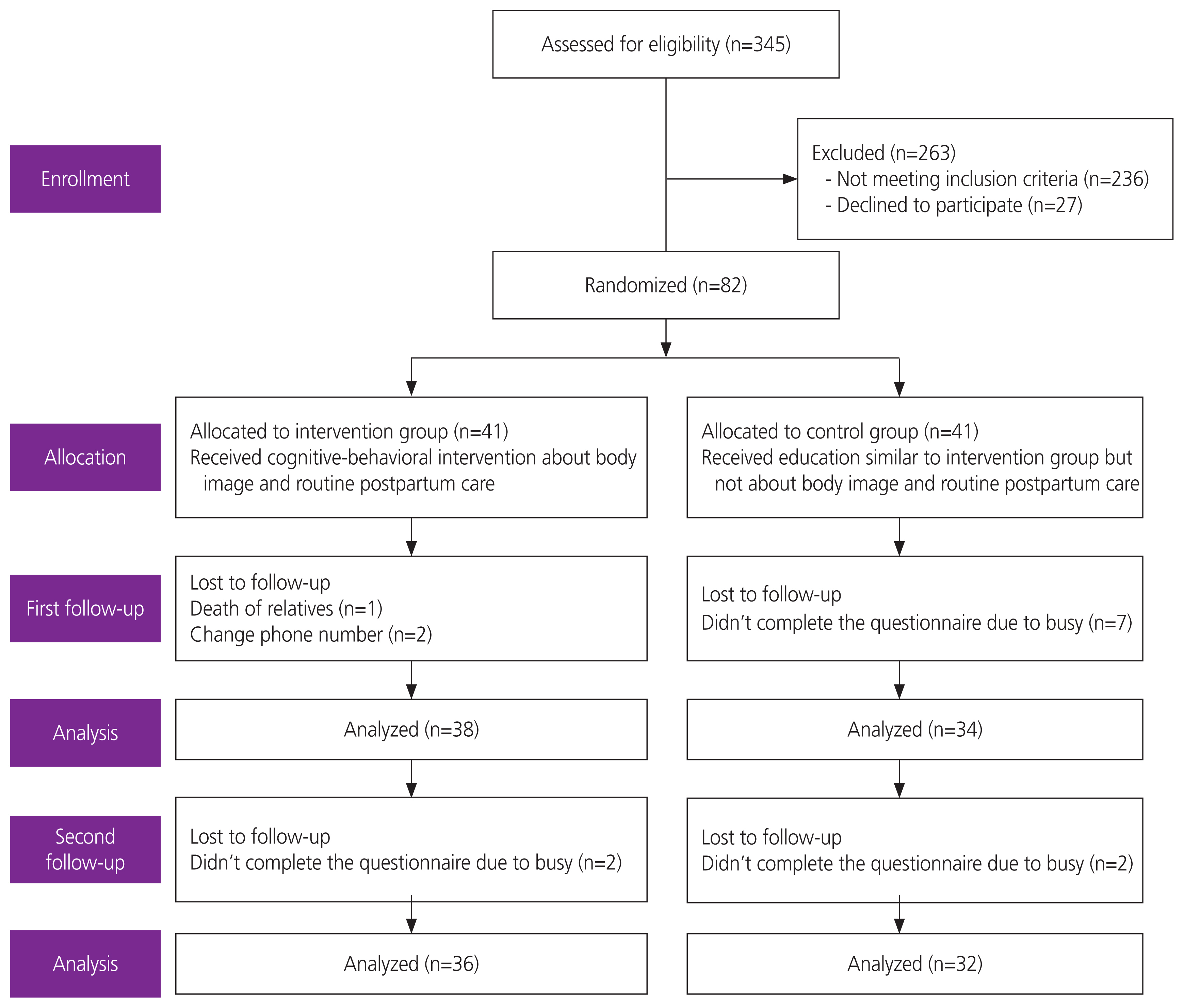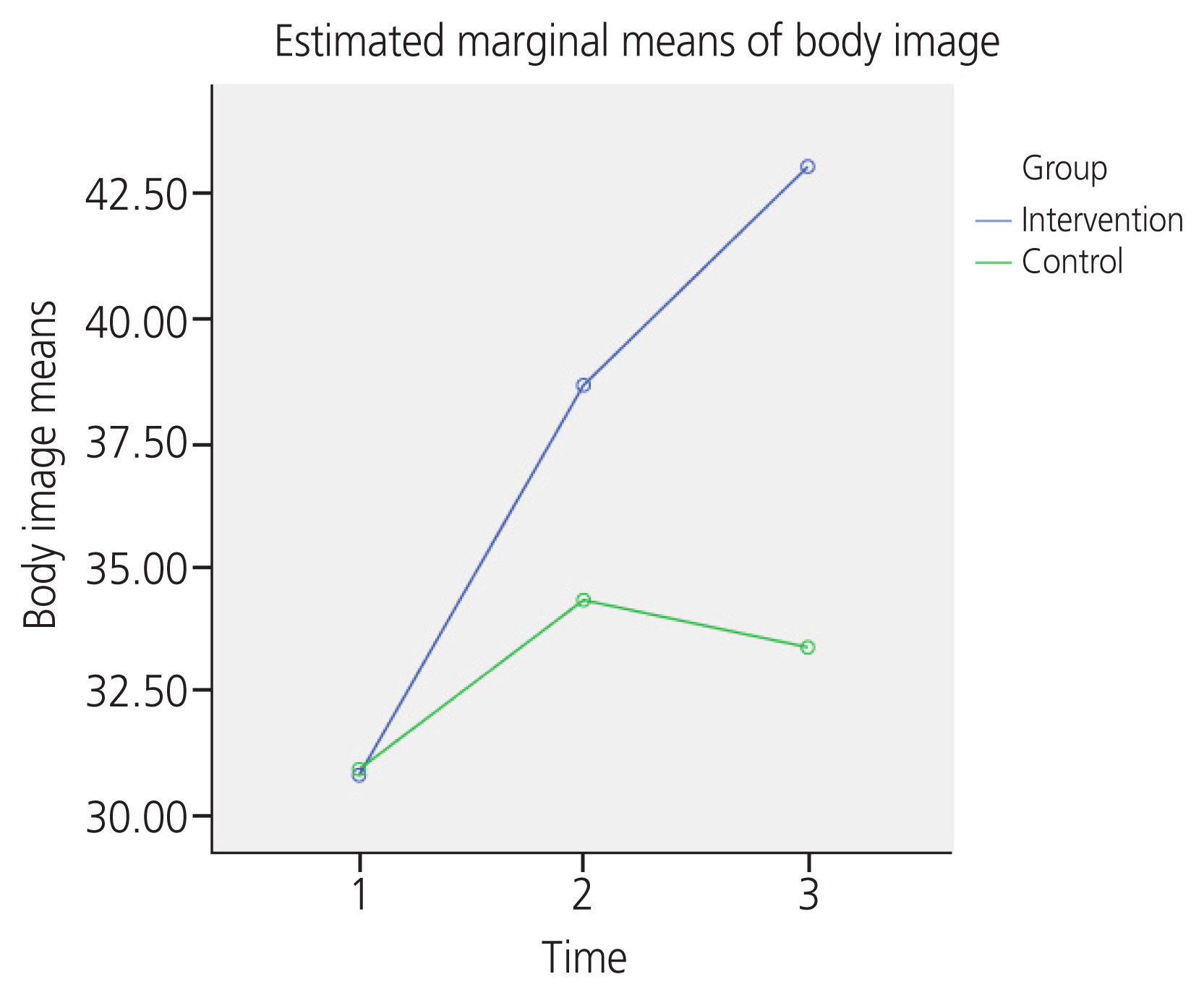Obstet Gynecol Sci.
2022 Nov;65(6):502-512. 10.5468/ogs.22079.
Improving body image and sexual life among postpartum women: a single-blind-randomized controlled trial to evaluate a social network-based cognitive-behavioral intervention
- Affiliations
-
- 1Sexual and Reproductive Health Research Center, Mazandaran University of Medical Sciences, Sari, Iran
- 2Department of Epidemiology and Biostatistics, School of Medicine, Urmia University of Medical Sciences, Urmia, Iran
- 3Department of Psychiatry, Psychiatry and Behavioral Sciences Research Center, Addiction Institute, School of Medicine, Sari, Mazandaran University of Medical, Iran
- 4Department of Public Health and Community Medicine, Tufts School of Medicine, Boston, MA, USA
- 5Department of Midwifery and Reproductive Health, Sexual and Reproductive Health Research Center, Mazandaran University of Medical Sciences, Sari, Iran
- KMID: 2535958
- DOI: http://doi.org/10.5468/ogs.22079
Abstract
Objective
To determine the effect of a social network-based cognitive-behavioral intervention on postpartum body image and sexual life of primiparous women.
Methods
In this single-blind randomized controlled trial, 82 postpartum women were allocated into two intervention and control groups (allocation ratio, 1:1) using permuted block randomization. Primary outcome was change in body image scores between the groups over time. Secondary outcomes were genital self-image, sexual quality of life, and sexual satisfaction. The intervention group participated in eight (2 weeks) 60-minute sessions through WhatsApp (WhatsApp Inc., Mountain View, CA, USA). Data were collected at recruitment, post-intervention, and 1-month of follow-up.
Results
Cognitive-behavioral intervention had a medium effect on improving body image in postpartum women (partial eta squared, 0.33; P<0.001). The results showed significant differences between the two groups regarding sexual quality of life and sexual satisfaction at 1-month follow-up.
Conclusion
The results of this study can be used to develop psychological interventions targeting body image in postpartum women.
Keyword
Figure
Reference
-
References
1. Cash TF, Theriault J, Annis NM. Body image in an interpersonal context: adult attachment, fear of intimacy, and social anxiety. J Soc Clin Psychol. 2004; 23:89–103.2. Cash TF, Fleming EC. The impact of body image experiences: development of the body image quality of life inventory. Int J Eat Disord. 2002; 31:455–60.
Article3. Bordo S. Unbearable weight: feminism, western culture, and the body. 2nd ed. Oakland: Univ of California Press;2004.4. Træen B, Markovic A, Kvalem IL. Sexual satisfaction and body image: a cross-sectional study among Norwegian young adults. Sex Relatsh Ther. 2016; 31:123–37.5. Cash TF, Smolak L. Body image: a handbook of science, practice, and prevention: 2011. 2nd ed. New York (NY): Guilford Press;2012.6. Ginzburg DM, Bohn C, Höfling V, Weck F, Clark DM, Stangier U. Treatment specific competence predicts outcome in cognitive therapy for social anxiety disorder. Behav Res Ther. 2012; 50:747–52.
Article7. Bishop MJ. The ‘mommy lift’: cutting mothers down to size. Motherhood in American popular culture. 1st ed. Westport (CT): Praeger;2009.8. Chae J. Interest in celebrities’ post-baby bodies and Korean women’s body image disturbance after childbirth. Sex Roles. 2014; 71:419–35.
Article9. Soler PT, Fernandes HM, Damasceno VO, Novaes JS. Vigorexia e níveis de dependência de exercício em frequentadores de academias e fisiculturistas. Rev Bras Med Esporte. 2013; 19:343–8.
Article10. Grogan S. Body image: understanding body dissatisfaction in men, women and children. 4th ed. London: Taylor & Francis;2016.11. Smolak L, Murnen SK, Thompson JK. Sociocultural influences and muscle building in adolescent boys. Psychol Men Masc. 2005; 6:227–39.
Article12. Miller MN, Pumariega AJ. Culture and eating disorders: a historical and cross-cultural review. Psychiatry. 2001; 64:93–110.
Article13. Andaroon N, Kordi M, Kimiaei SA, Esmaeili H. Relationship between intensity of fear of childbirth with choosing mode of delivery in primiparous women. The Iranian Iran. J Obstet Gynecol Infertil. 2017; 20:68–75.14. Sun W, Chen D, Wang J, Liu N, Zhang W. Physical activity and body image dissatisfaction among pregnant women: a systematic review and meta-analysis of cohort studies. Eur J Obstet Gynecol. 2018; 229:38–44.
Article15. Bell BT, Taylor C, Paddock D, Bates A. Digital bodies: a controlled evaluation of a brief classroom-based intervention for reducing negative body image among adolescents in the digital age. Br J Educ Psychol. 2021; 92:280–98.16. Cerea S, Ghisi M, Bottesi G, Manoli T, Carraro E, Doron G. Cognitive behavioral training using a mobile application reduces body image-related symptoms in high-risk female university students: a randomized controlled study. Behav Ther. 2021; 52:170–82.
Article17. Cash TF, Brown TA. Body image in anorexia nervosa and bulimia nervosa: a review of the literature. Behav Modif. 1987; 11:487–521.18. Posavac HD, Posavac SS, Weigel RG. Reducing the impact of media images on women at risk for body image disturbance: three targeted interventions. J Soc Clin Psychol. 2001; 20:324–40.
Article19. Pruzinsk T. Enhancing quality of life in medical populations: a vision for body image assessment and rehabilitation as standards of care. Body Image. 2004; 1:71–81.
Article20. Schwartz MB, Brownell KD. Obesity and body image. Body Image. 2004; 1:43–56.
Article21. Cash TF, Hrabosky JI. The effects of psychoeducation and self-monitoring in a cognitive-behavioral program for body-image improvement. Eating Disorders. 2003; 11:255–70.
Article22. Strang VR, Sullivan PL. Body image attitudes during pregnancy and the postpartum period. J Obstet Gynecol Neona. 1985; 14:332–7.
Article23. Hurt K, Walker RJ, Campbell JA, Egede LE. mHealth interventions in low and middle-income countries: a systematic review. Glob J Health Sci. 2016; 8:183.
Article24. Kay M, Santos J, Takane M. mHealth: new horizons for health through mobile technologies. Geneva (CH): World Health Organization;c2011. [cited 2011 Jun, 12]. [Avilable from: http://www.who.int/goe/publications/goe_mhealth_web.pdf .25. Rodgers RF, Donovan E, Cousineau T, Yates K, Mc-Gowan K, Cook E, et al. BodiMojo: efficacy of a mobile-based intervention in improving body image and self-compassion among adolescents. J Youth Adolesc. 2018; 47:1363–72.
Article26. Brown TA, Cash TF, Mikulka PJ. Attitudinal body-image assessment: factor analysis of the body-self relations questionnaire. J Pers Assess. 1990; 55:135–44.
Article27. Shemshadi H, Shams A, Sahaf R, Shamsipour Dehkordi P, Zareian H, Moslem AR. Psychometric properties of persian version of the multidimensional body-self relations questionnaire (MBSRQ) among Iranian elderly. Iran J Ageing. 2020; 15:298–311.
Article28. Sabbaghan M, Malakouti J, Mirghafourvand M, Hakimi S, Ranjbar F. The effect of training package on genital self-image and sexual function: a randomized controlled clinical trial. Iran Red Crescent Med J. 2017; 19:e14453.
Article29. Symonds T, Boolell M, Quirk F. Development of a questionnaire on sexual quality of life in women. J Sex Marital Ther. 2005; 31:385–97.
Article30. Maasoumi R, Lamyian M, Montazeri A, Azin SA, Aguilar-Vafaie ME, Hajizadeh E. The sexual quality of life-female (SQOL-F) questionnaire: translation and psychometric properties of the Iranian version. Reprod Health. 2013; 10:1–6.
Article31. Meston C, Trapnell P. Outcomes assessment: development and validation of a five-factor sexual satisfaction and distress scale for women: the sexual satisfaction scale for women (SSS-W). J Sex Med. 2005; 2:66–81.
Article32. Roshan CR, Mirzaei S, Nikazin A. Validity and reliability of multidimensional sexual satisfaction scale for women (SSSW) in one sample of Iranian women. Clin Psychol. 2014; 12:129–40.33. Hodgkinson EL, Smith DM, Wittkowski A. Women’s experiences of their pregnancy and postpartum body image: a systematic review and meta-synthesis. BMC Pregnancy Childbirth. 2014; 14:1–11.
Article34. Paxton SJ, McLean SA, Gollings EK, Faulkner C, Wertheim EH. Comparison of face-to-face and internet interventions for body image and eating problems in adult women: an RCT. Int J Eat Disord. 2007; 40:692–704.
Article35. Nicolino JC, Martz DM, Curtin L. Evaluation of a cognitive-behavioral therapy intervention to improve body image and decrease dieting in college women. Eat Behav. 2001; 2:353–62.
Article36. Van Lankveld J. Internet-based interventions for women’s sexual dysfunction. Curr Sex Health Rep. 2016; 8:136–43.
Article37. Hummel SB, van Lankveld JJDM, Oldenburg HSA, Hahn DEE, Kieffer JM, Gerritsma MA, et al. Efficacy of internet-based cognitive behavioral therapy in improving sexual functioning of breast cancer survivors: results of a randomized controlled trial. Am J Clin Oncol. 2017; 35:1328–40.
Article38. Yazdani M, Mahmoodi Z, Azin SA, Qorbani M. The effect of counseling based on sexual self-concept via social networks on smartphone in infertile women: a randomized controlled trial. IJCBNM. 2019; 7:231–40.39. Andersson G. Using the internet to provide cognitive behaviour therapy. Behav Res Ther. 2009; 47:175–80.
Article40. Berman L, Windecker MA. The relationship between women’s genital self-image and female sexual function: a national survey. Curr Sex Health Rep. 2008; 5:199–207.
Article41. Ackard DM, Kearney-Cooke A, Peterson CB. Effect of body image and self-image on women’s sexual behaviors. Int J Eat Disord. 2000; 28:422–9.
Article
- Full Text Links
- Actions
-
Cited
- CITED
-
- Close
- Share
- Similar articles
-
- Factors Influencing Sexual Satisfaction in Patients with Breast Cancer Participating in a Support Group and Non Support Group
- Relationship Between Postpartum Depression and Body Image in Postpartum Women
- Maternal Health Effects of Internet-Based Education Interventions during the Postpartum Period: A Systematic Review
- The Effectiveness of Progressive Muscle Relaxation on the Postpartum Quality of Life: A Randomized Controlled Trial
- Four-Week, Home-Based, Robot Cognitive Intervention for Patients with Mild Cognitive Impairment: a Pilot Randomized Controlled Trial



